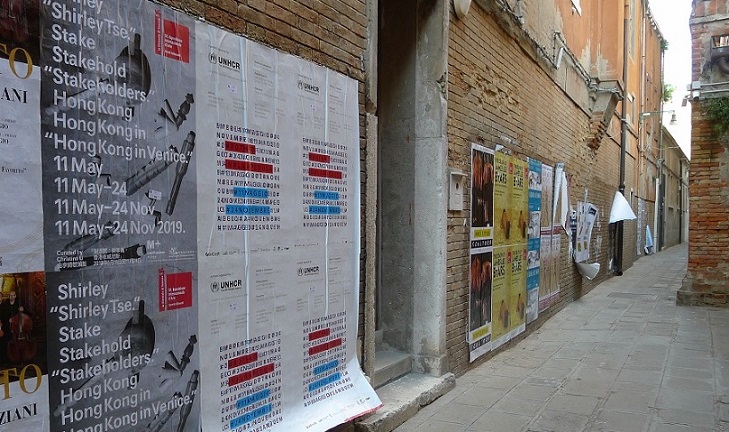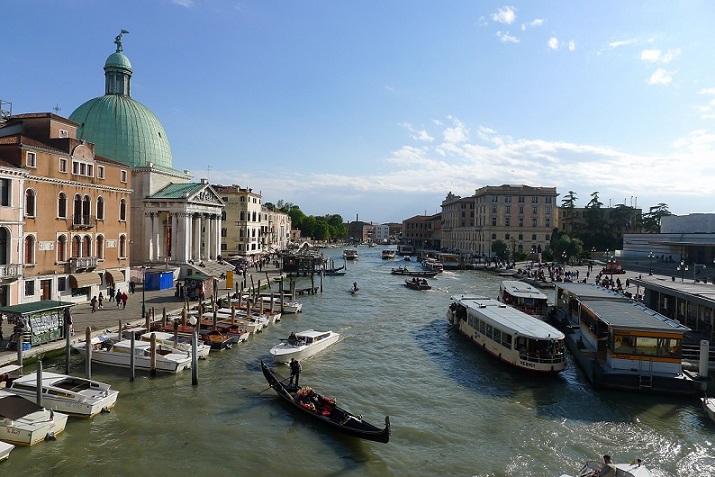Reviews & Articles
從開幕盛況到藝術至上:舉世矚目的威尼斯雙年展 | Art Takes Centrestage After Venice Biennale Opening
John BATTEN
at 9:05pm on 21st June 2019


圖片說明:
威尼斯街頭張貼著海報,宣傳謝淑妮在香港館舉行的展覽。照片由作者提供
Caption:
Street posters in Venice advertising Shirley Tse’s exhibition in the Hong Kong Pavilion. Photo: John Batten
(Please scroll down for English version)
國際外交界每年都會因為威尼斯的藝術活動聚首該市。第58屆威尼斯雙年展是現時至2019年11月24日舉行的展覽,它的意大利語全稱是La Biennale di Venezia – 58. Exposizione Internazionale d’Arte,英語媒體一般簡稱為「The Venice Biennale」。「La Biennale di Venezia」本身是一個正規組織,由一個(意外地小規模的)董事會率領。組織也涉獵其他藝術形式,並專注舉辦不同藝術節。據該會解釋,這些藝術活動「……引領當代藝術新潮流的研究與推廣工作,為各領域舉辦展覽和進行研究,計有:藝術(自1895年起辦)、建築(1980年起辦)、電影(1932年起辦)、舞蹈(1999年起辦)、音樂(1930年起辦)及劇場(1934年起辦)」。
要體會這些活動的重大意義,便須親身到訪威尼斯,親睹當地氛圍。我在上個月才首次踏足意大利威尼斯與雙年展,出席為期數天的視覺藝術展覽開幕禮。雖說我已明白雙年展的後勤運作,加上威尼斯本身相對地簡單(詳見下文),但我此前並未意識到雙年展這項國際盛事,包含著備受國家與本土關注的元素。
威尼斯是一個不同凡響的城市。它的歷史空間、廣場、教堂和運河,經歷了數以百年計的歲月,是建築、宗教和藝術奇跡的集中地––世界上幾乎沒有一個像她一樣獨特的地方。這個城市沿大運河向外延伸,並以聖馬可廣場為中心。由於威尼斯本身佔地不大,要在市內穿梭相對上簡單。然而,旅客卻須行動自如,因為市內很多小橋和古老建築都需要爬樓梯才可到達。威尼斯著名的水上巴士意語稱為vaporetto,沿著大運河主流與交錯支流游走,它們是前往威尼斯潟湖內其他小島的重要交通公具。如果你有不少行李,水上巴士也相當重要。當然,最好還是輕裝遊歷威尼斯。威尼斯的火車站位於大運河上,擁有自己的水上巴士站;機場同樣可以小輪接駁,因此,大部份旅客都會經海路前往住宿點附近,可說是探索這個城市的奇妙引子。
不少國家或地區都在單數年份參與視覺藝術雙年展,在雙數年份則參加建築雙年展,香港也是一樣。展覽主要在兩大地點舉行,兩個展點均位於與聖馬可廣場步行可達之處。在雙年展期間,進場參觀需要購買門票。很多人認為在花園區(Giardini,意大利語「花園」的意思)舉辦的展覽較具聲望。這個公共公園在年展期間圍封起來成為展區,裡面滿佈參展國家的建築物,稱為展館。每間展館的建築都顯示了參展國的特色,物業屬參展國所有,參展國家每年都會在自己的展館舉辦展覽。設於花園區的國家級展館,展現了威尼斯雙年展的舊世界起源:雙年展於1895年首辦,所以花園區內由歐洲國家展館主導,也包括韓國、委內瑞拉和澳洲等其後加入的國家。由於花園區內空間有限,所以其他國家的新展館不可以建於這裡。結果,中國等大國的展館都不是設於花園區內。
雙年展另一個主場館位於兵工廠,也很接近聖馬可廣場。兵工廠的歷史可以追溯至12世紀,這裡曾是威尼斯海軍力量中心,讓該市的勢力縱橫地中海海面與各貿易路線,為威尼斯建立了豐厚財富。兵工廠的前身是一家規模龐大的造船及維修工廠,管理上幾近現代生產線與工業廠房。舉辦雙年展的場地都是樓底甚高的歷史木構建築,它們與彼此融為一體,延綿數公里。走進場地,原兵工廠的間隔與房間成為了其他國家的臨時展館。兵工廠也主辦由雙年展本身贊助的主要展覽,盛大地展示來自世界各地藝術家的作品。本年展覽題為《願你生活在有趣的時代》,觀眾可以在這裡綜觀當代藝術家現時所關心的主題和形式,流離失所、難民、暴力等。
一些參展國家選擇不在兵工廠區展覽,因為它們認為在威尼斯另一部份物色場地,可能會得到更佳的曝光。在雙年展期舉行期間,也有很多其他展覽同時開辦。例如,Prada 基金會便舉行了一場令人印象深刻的展覽,主角是影響力深遠的希臘/意大利藝術家Jannis Kounellis。所以,部份國家特意把展館設於這場展覽附近,沾沾這位國際藝術家的光芒,希望觀眾可以稍移玉步,順道參觀。
雙年展的開幕日是一場忙亂的國家身份展演。傳統上,花園區展館在第一天開幕,每間都準時準點地每隔半小時逐一開幕。同樣情況第二天在兵工廠區再次出現。儘管各國展館都可以趁此良機向更廣更大國際藝術觀眾展示佳作,然而,現身很多展館(包括香港館)的,卻是一同出席主持開幕儀式的藝術官員和政府高官,他們也拜會其他展館的同級官員,並發表較適合本國觀眾和媒體的致辭。
當然,香港並不是國家,所以它在威尼斯雙年展中的參與只是官方的「平行展」。然而,香港也複製了很多國家館的裝飾,而且是由香港藝術發展局聯同M+博物館主辦。由兩大機構主辦或「委約」的做法並不常見,大部份其他國家的展覽只有一個主辦機構;工作上的重覆,香港實應加以檢討。
香港的展館選址位於兵工廠入口外,位置非常方便;這裡展出了藝術家謝淑妮的精彩作品。展館與兵工廠內的其他展館同日開幕。根據雙年展的官方新聞稿,香港館的開幕時間原定為下午4.30。然而,因為一個備受評論的決定,一些官員希望出席當日較早時間舉行的中國館開幕儀式以「亮亮相」、「給給面子」。為了遷就中國館與香港館之間一段不短的步行距離,香港館的開幕時間結果不必要地延遲了10分鐘,改到下午4.40。這個改變似乎微不足道,但試想像如果其他展館也作出類似的時間改變,眾多預定開幕時間豈不大出亂子?探訪中國館是很好的禮節,但香港官員無非不能簡單地解決問題,提早前往中國館就可以了?
威尼斯雙年展開幕的兩天,國家與本土姿態紛紛先聲奪人,但在所有開幕氣氛散去後,藝術名正言順地成為了盛會的主角。
參考資料:
www.laBiennale.org/en
https://vbexhibitions.hk
www.fondazioneprada.org/project/jannis-kounellis/?lang=en
原文刊於《明報周刊》,2019年6月8日
Art Takes Centrestage After Venice Biennale Opening
by John Batten
The world of international diplomacy comes to Venice every year through its art events. Currently on exhibition until 24 November 2019 is the 58th edition of ‘La Biennale di Venezia – 58. Exposizione Internazionale d’Arte’, to give it its full name in Italian – usually shortened to ‘The Venice Biennale.’ However, La Biennale di Venezia is a formal organization led by a (surprisingly small) Board of Directors that also encompasses other art forms and has dedicated festivals which is, as it explains, “…at the forefront of research and promotion of new contemporary art trends, organizes exhibitions and research in all its specific sectors: Arts (since 1895), Architecture (1980), Cinema (1932), Dance (1999), Music (1930), and Theatre (1934).”
The significance of these events can only be appreciated by visiting Venice to see what is happening. I made only my first visit to Italy, Venice and the Venice Biennale last month to attend the opening days of the (visual arts) Venice Biennale. Understanding the logistics of the Biennale and Venice is relatively simple (see below), but I had not appreciated the extent that the Biennale is an international event with both national and domestic concerns.
Venice is a remarkable place. Its historic places, piazzas, churches and canals date back centuries and is a unique concentration of architectural, religious and artistic wonders – there is almost nowhere else like it in the world. The city spreads itself along and outwards from the Grand Canal and from its ‘centre’, St Mark’s Square. Getting around Venice is relatively simple as it is not a physically big place. Visitors, however, should be mobile as the city’s many bridges and older buildings involve climbing stairs. The city’s waterbuses, the famous vaporetto, travel along and criss-cross the Grand Canal and are essential to get to other islands around the Venetian lagoon, or, if you have luggage – but, it is best to travel light. Venice’s train station is located directly on the Grand Canal and has its own vaporetto stop. The airport also has ferry connections – so, most visitors will use the sea to arrive near their accommodation: a magical introduction to the city.
Many countries or regions, as in Hong Kong’s case, participate in the visual arts (in odd years) and architecture (in even years) Biennales. There are two main locations in which exhibitions are featured; and both are walking distance from St Mark’s Square. During the Biennale entry is by paid ticket. Considered by many as the more prestigious, the Giardini (‘garden’ in Italian) is a fenced-off public park that has individual participating country’s buildings (referred to as pavilions) scattered around the gardens. The architecture of each pavilion displays aspects of the character of the country and is the property of individual countries; each year they will use their pavilion to mount a display. The national pavilions in the Giardini, reflecting the old-world origins of the Venice Biennale, which began in 1895, sees European nations dominate. A few later inclusions – Korea, Venezuala and Australia – are also present. The limited space in the Giardini means no new pavilions for other countries will be built. Consequently, other prominent countries, including China, are not located in the Giardini.
The other main Biennale venue, also close to St Mark’s Square, is the Arsenale. Dating back to the 12th century, the Arsenale was the centre of Venetian naval power, allowing the city to dominate the seas and trade routes of the Mediterranean and build its fantastic wealth. The Arsenale was a huge shipbuilding and repair factory, managed as an almost-modern production-line and industrial facility. The Biennale is held in the historic high-ceiled wooden-trussed buildings that merge into each other and literally run for kilometres. Inside, using sections and rooms of the old Arsenale, are other countries’ temporary national pavilions. The Arsenale also hosts the main curated exhibition sponsored by the Biennale itself – a huge sprawling display of artists from around the world. This year’s exhibition, May You Live in Interesting Times, gives an excellent overview of the themes (displacement, refugees, violence, etc) and forms that contemporary artists are currently concerned with.
Some exhibiting countries choose not to exhibit inside the Arsenale, figuring that they may have better exposure by finding a venue in another part of Venice. During the Biennale there are numerous other exhibitions running concurrently. For example, the Prada Foundation has mounted an impressive exhibition of the influential Greek/Italian artist Jannis Kounellis. So, some countries have purposely located their pavilions nearby, piggy-backing on the lure of this international artist and counting on visitors to make a short detour to see their pavilions.
The opening day of the Biennale is a frantic showcase of national identity. The pavilions in the Giardini traditionally open on the first day and with clockwork precision openings are timed every half-hour. This is replicated in the Arsenale on the second day. Despite this fabulous opportunity to showcase their pavilion’s art to a larger international arts audience, many pavilions, however, including Hong Kong, see officiating arts bureaucrats and government officials remaining together, visiting equivalent officials in other pavilions, and making speeches more appropriate for their own domestic audiences and press.
Hong Kong is, of course, not a country, so its participation at the Venice Biennale is as an official “collateral event”. However, Hong Kong has replicated many of the trappings of a country pavilion and its participation is organized by the Hong Kong Arts Development Council and the M+ Museum. Having two organizing or “commissioning” organisations is unusual, most other countries only have one: Hong Kong should review this, because of the duplication of tasks.
Hong Kong’s pavilion with its wonderful display of art by artist Shirley Tse is conveniently located just outside the Arsenale entrance and opened on the same day as those inside the Arsenale. Its scheduled opening time was announced in the official Biennale press release as 4.30pm. However, in a much-commented decision, some officials wanted to ‘show face’ by also attending the earlier opening ceremony at the Chinese pavilion – whose pavilion was a long walk from Hong Kong’s. Hong Kong’s opening was therefore unnecessarily delayed by ten minutes, to 4.40pm. This appears a minor change, but imagine the chaos of openings if other pavilions made similar time changes? Visiting the Chinese is good protocol, but couldn’t Hong Kong officials have simply arrived at the Chinese pavilion earlier?
The Venice Biennial’s opening two days is a scramble of national and domestic posturing, but after all the opening fuss, the art, quite rightly, eventually takes centrestage.
Links for further info:
www.labiennale.org/en
https://vbexhibitions.hk
www.fondazioneprada.org/project/jannis-kounellis/?lang=en
Originally published in Ming Pao Weekly, 8 June 2019. Translated from the original English by Aulina Chan.
|
|
|
|
|
|
